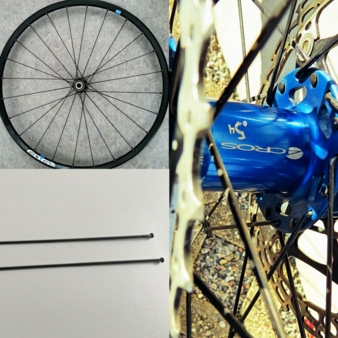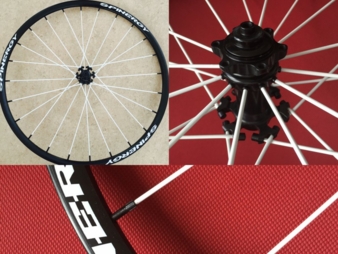01/07/2015 — auf Deutsch lesen
TU Chemnitz: Textile spokes
Bicycle wheels are enabling new scales in performance and weight for the development of bicycle wheels. Thereby, the replacement of spokes, made from steel, can be performed. Textile high performance spokes can be in use in a growing number of conveyances. Synonymous to this, a high spectrum of variable mechanic properties can be set for each field of application.
Wheels, which are state of the art, except special wheel sets, have following design. A special formed wheel hub, which is designed for a high tensile stresses in the spokes, enables the layout of an amount of spokes. The spokes itself are head sided cropped or straight. The main shape of the spokes is characterised by a head of the spokes and a thread on the other end. The thread enables the introduction of the force, which is necessary for the stability of the wheel.
Third part of the wheel is the rim. It includes a determined amount of admitting facilities for the spokes, like the wheel hub. This amount is according to the design of the wheel. The rim contains spaces for the spoke nipples, which are used like a nut. Due to their design, they enable a displacement in angle, based on the radial direction of the rim. (cf. figure 1)
In total, you get a wheel with comparatively high weight and changing properties, which are due to changing tyre pressures. The points of force introduction for the spoke on the wheel hub are also disadvantageous.
Spinergy, a system provider for special wheel sets, developed a wheel set, which is designed for high performance fibres. Parallel oriented PBO® fibres are in use for their spokes. All fibres are embedded in a jacket of polyurethane. This jacket is protecting the spokes from influences like dust, UV radiation, wet conditions and mechanical influences like flying stones etc. Head and thread are pressed onto the epoxy resin impregnated ends of the spokes. (cf. figure 2)
To develop spokes, which are made for bearing the load while being used in bicycle wheels, you have to summarize the current state. Therefore, tensile tests on common steel spokes have been performed. Further, a research on the tensile loads occurring in spokes has shown that break load of at 1,000 to 1,500 N is required to prevent failure of the spokes during use.
The results of tensile tests on steel spokes (cf. figure 3) showed a breaking force of nearly 2.900 N. Thus, a safety factor of about SF = 2 against failure in application is obtained. Comparing these results to the tensile tests on textile spokes, made by Spinergy, following behaviour occurs (cf. figure 4).
It can be seen that there is a higher potential in the textile spokes, compared to the common steel spokes. The detected safety factor against failure in application is at least SF = 3. Simultaneously, there is a comparability in the elastic behaviour between steel spokes and textile spokes.
Because of the knowledge on the behaviour of steel spokes and the spokes from Spinergy, new textile high performance spokes have been designed. To reinforce the whole function of the textile, there is no jacket around the braided rope. The result of the development was a braid made of Technora T200, with a diameter of 2.2 mm. The Force-Elongation-Curve in elastic region corresponded to the behaviour of the PBO-Spoke from Spinergy. Failure occurred at about 5.200 N. First step was the development of a special end connection, to enable determining the behaviour of the cross section of the braid. (cf. figure 5)
The usage of end connections is weakening the ropes, so a new layout design of the spokes and the wheel hub was chosen. By doing so, the strain force of the spokes has also been optimized. The lead of a textile spoke starts at the rim, runs over a pin on the wheel hub (spoke area 1), which is the reverse point, and leads back to the rim (spoke area 2). A tensioning mechanism is fixed to the rim on both ends of the rope (cf. figure5). The Euler´s law is applicable by using a wrap angle on the wheel hub, in order to decouple both spoke areas. Thus, differences in the strain can be avoided.
Additional tensile tests have been performed to find the forces for accurately centring the wheel. A special tensiometer has been applied, in this case. This tensiometer is detecting the deformation between three points. The higher the force in the spoke, the less deformation has been detected with the tensiometer. (cf. figure 6)
In this way, the wheel has been centred by applying equal tensile forces of 1.100 N to the spokes. The assembled wheel has been tested and provided comfortable driving behaviour in a standard bicycle. (cf. figure 7)
The investigations show the potential of using high performance fibre ropes in designing bicycle wheels. There is a number of advantages associated to the variability in design and quantity in material in the use of high performance fibres:
-powerful symbiosis between wheel hub, spoke and rim
-use of commercial rims
-new weight-reduced wheel hub designs
-adjustable dampening qualities, based on the design of the spokes
-high potential adjusting wheel sets to different types application (city bikes, e-bikes, mountain bikes, wheel chairs etc.)
-lightweight capability
There is a need for additional research and development, based on the mentioned studies, which is expressed as follows:
-development of an reliable light-weight end connection
-prevention of twist in the textile spoke while tensioning it
-redesigning of the textile spoke regarding diameter, jacket and layout of the wheel
After finishing these studies, the new wheel is intended to be appropriate for different field tests. After these field tests, the general suitability of the textile high performance spoke should be assessed. Parts of the wheel, especially the hub, the rim and the spoke by itself have to be developed further and have to be subjected to different tests, additional to the described field tests.
The main potential of the described high performance spoke is the weight reduction. In comparison of textile fibre spokes to steel spokes, there is a possibility to reduce the weight by 80 %. Redesigning of the wheel hub and adjustment of the pre-tension in the spokes is possible; there is also a potential on weight reduction.
With this knowledge, wheels can be designed application-oriented. There is the possibility to take care of the mass distribution while the process of designing the wheels. Wheels with high dampening behaviour or stiff wheels are imaginable, based on the shown design.
[Daniela Storch M.A., Dipl.-Ing. Ingo Berbig, Prof. Dr.-Ing. Markus Michael]





